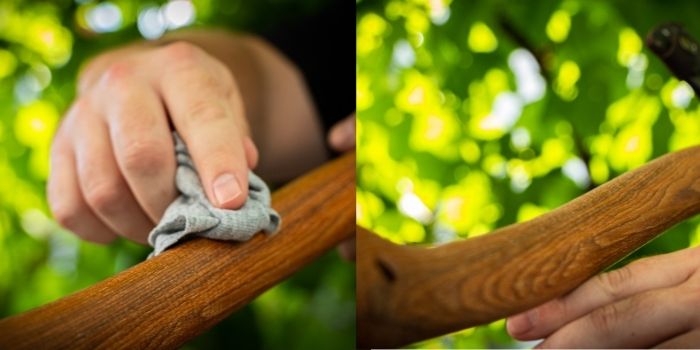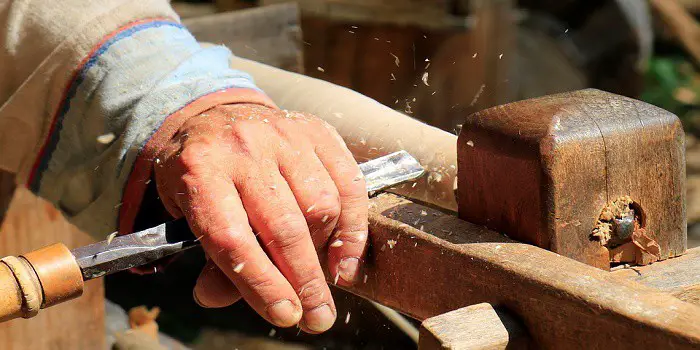
Although the handles for axes tend to be durable and long-lasting, the ones made from wood will still need proper maintenance.
This normally means adding an oil such as linseed oil to the handle to keep the wood from prematurely drying out.
In short, if you have the time, raw linseed oil works the best. But if you are in a hurry and take precautions, then boiled linseed oil is a good alternative.
Keep in mind that using the proper type of oil will help preserve the axe handle for a long.
This means that when the axe is stored in a cool, dry place, it will be more resistant to rot, weathering, and other issues that otherwise would compromise the wood.
So, before you apply or rub any type of oil into the handle, it pays to know which ones work the best and why.
The Best Oils for Wooden Axe Handle
The type of oils normally used for oiling ax handles is known as drying oils. These are oils that harden once they dry and help seal up the wood.
Most drying oils that are used include hemp, teak, tung, and walnut.
Other types of oil such as coconut and olive oil do not dry and harden. This means that the oil will simply seep out and not do the wooden axe handle any good.
IMO, the most popular type of drying oil for axe handles is linseed oil.
Whether linseed oil is the best may be debatable, but what is true is that linseed oil is cheap, readily available, and dries quickly.
Linseed oil comes from pressing the dried seeds found in flax plants. This is why linseed oil is sometimes known as flax or flaxseed oil.
Once applied for the finishing of the axe handle, the linseed oil dries and polymerizes fast.
This means it becomes solid and hardens which seals up the porous surface of the wood.
However, whichever oil you choose, it should be applied to the axe handle in roughly the same way.

How to Treat Your Axe Handle with Oil?
Once the oil is selected, you will need to prep the wood handle of your tool.
If there is any varnish on the wood, remove it using a sharp knife.
Drag the cutting edge of the blade along the surface to remove any varnish from the handle.
Then, rub the handle with 200-grit sandpaper to catch any leftover varnish and smooth out the surface.
Once completed, a paper towel should be used to remove all the dust.
Now you are ready to gather the supplies.
Be sure to wear gloves and eye protection, work in a well-ventilated area, and use either a clean rag or shop towels to apply the oil. Now you are ready to get started.
Step 1- Apply the Oil:
Pour some linseed oil on the clean rag or shop towel. Now wipe the oil across the surface of the handle using the rag.
Be sure to cover the entire surface, including both ends.
A thin layer of oil is sufficient as too much will not be properly absorbed.
Step 2- Let the Oil Dry:
You can place the axe under the sun or in the wind to dry out faster.
You will want to wait until the oil has fully dried before adding the next coat.
Step 3- Two More Coats of Oil:
You’ll want to repeat the process two more times of adding oil. There is no need to sand or strip the handle again.
Just add a second thin coat of linseed oil, let it dry, and add a third coat and let it dry.
Once the third coat of linseed oil has dried, you are ready to use the hatchet.
Now at this point, you may ask which type of linseed oil is the best, raw or boiled? Let’s have a look…
Raw or Boiled Linseed Oil for Finishing Axe Handles?
Opinions differ on whether raw or boiled linseed oil is the best for coating the handle of an axe or hatchet.
What can be stated as true is that the term “boiled” is misleading.
The linseed oil is not boiled in the sense that it has been heated.
Rather, an additional amount of chemical drying agents has been added to the oil.
The reason is to cause the oil to dry faster compared to its raw or natural form.
The advantage of boiled linseed oil is that it takes considerably less time for it to dry compared to raw linseed oil.
The disadvantage which is a small one is that the chemical dryers will heat up as the oil dries on the wood.
Under rare circumstances, this may cause a fire to break out.
But if you place the handle on a solid, non-flammable surface with plenty of air circulation there should be no danger.
Raw linseed oil does not carry the possibility of heating up since it contains fewer chemical drying agents.
However, it will take far longer under normal conditions for the handle to dry.
For the five minutes it takes to apply a single thin coat, you can expect the raw linseed oil to take a full day to dry. This means if you have three to four days, raw linseed oil works quite well.
Share the post "Boiled or Raw Linseed Oil – What’s Better for Axe Handle?"

Hi, I am Mark Garner a professional carpenter, woodworker, and DIY painter. I live in the small city of Peoria, Arizona as a semi-retired woodworker. I have started this blog with a simple motive to help you with my wood experience in this sector. If you like to know more about what I love doing and how it all got started, you can check more about me here.





